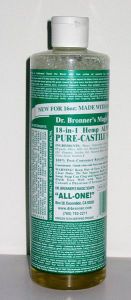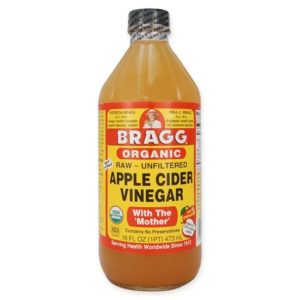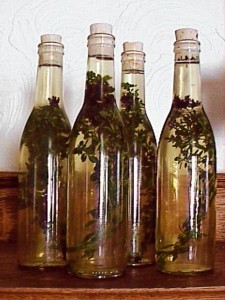By Cat, Aug 2008 (Photo, right, from Wikimedia Commons)
In the not too distant past, homemakers routinely made their own cleaning and personal care products from ingredients in their own kitchens. As fuel costs rise and petroleum-based products become more scarce and expensive, we may once again return to the much more healthful practice of making our own, and it’s better for the environment too.
When I was growing up in my rural Montana town in the 1950s, many of the town families saved used lard and bacon fat in our kitchens for use by the local farm housewives for making kitchen and laundry soap. These same housewives also made more delicate soaps and lotions for personal care.
- Includes: Personal Care Products for: 1. Skin & Hair Ideas; 2. Vinegar Rinse Recipes
- See also: 1. Soap Basics; 2. Notes on Ingredients; 3. Homemade Cleaning Supplies, etc.; 4. Care of Cookware;
Skin and Hair Ideas
The following list is in alphabetical order.
Baking Soda
The next most important personal care product is baking soda. It can be used as toothpaste, deodorant, and on heavy soil. But really nasty greasy stuff probably won’t budge, even with a mix of castile soap and baking soda; in this case, try butter or olive oil.
Some uses for baking soda:
- Skin exfoliant: Make a paste with water and massage gently onto clean skin. Rinse well.
- Remove strong odors from hands or feet (such as garlic, fish odors). Make a paste with water and scrub hands/feet. Rinse well.
- Relaxing bath: add ½ cup baking soda to bath water. Especially soothing to dry, itchy skin, and provides some relief for poison ivy, skin rashes and mild sunburn.
- Mouthwash, or to refresh dentures or retainers: Mix 1 tsp baking soda into ½ cup filtered water.
- Toothpaste: Sprinkle ½ tsp baking soda in your palm; dampen toothbrush and work it into the soda to make a paste on your brush. Brush teeth.
- Deodorant: Mix ½ cup baking soda with 1 – 1 ½ Tbsp cornstarch. Store in plastic or glass container with lid. Dust onto underarms, or sprinkle into shoes.
Castile Soap & Vinegar/Lemon Juice Rinse
For most people, the most important personal care product is a good castile soap or glycerin soap. Either can be used to clean your whole body, and used as a shampoo for your hair. Then follow with a diluted vinegar rinse, to restore the acid mantle of your skin or hair. Soap can be drying, but the vinegar rinse greatly reduces the drying effect of soap. (See below for vinegar rinse recipes).
If you have sensitive skin, soap may be a bit too harsh, even with a vinegar rinse. In this case, raw milk, yogurt, homemade mayo, olive oil or almond oil can be used for cleaning your face and skin, but will not work as well for hair.
You might ask, what is the difference between Castile soap and glycerine soap? Both can be made with the same oils and lye, but glycerine soap also includes glycerine. Most glycerine soaps are translucent, made so by the addition of alcohol and sugar. (4) Glycerine (chemical name is glycerol) is the non-toxic backbone of all naturally occurring fats, which are called triglycerides.; as such, it is present in all soaps which are made from fats, but for glycerine soaps, pure glycerine is also added.
Coconut Oil
I use this on my face, especially when I get spots of eczema on each side of my nose and mouth, or in the folds of my ears. It doesn’t necessarily “cure” the eczema, as that is rooted in the liver, but it does make the spots more smooth and less noticeable. Plus it reduces the itch. No need to wash it off; it gets absorbed by the skin. See my post: Scalp and Facial Eczema: Seborrheic Dermatitis for more. See also “Honey” below.
Cucumber
Slices of cucumber can be placed over your eyes while you relax in a bath or a bed, to ease soreness or puffiness. Spent black tea bags can also be used for this purpose.
Honey
Raw honey is an excellent moisturizing masque. Pour a little honey in a bowl; dip your finger tips into the honey, then using just you finger tips, massage gently onto your skin in small circular motions, or by tapping. Rest for 5 minutes or so, then rinse off with barely-warm water.
I use this on my face (along with coconut oil) when I get spots of eczema on each side of my nose and mouth, or in the folds of my ears. For me the best time to do this is about an hoo before bed.
- I mix a tiny bit of Raw Organic Apple Cider Vinegar (the kind with the “mother”) with a bit of honey, and then apply it lightly to the red, itchy and possibly scaly spots. If needed, I pin my hair back so it doesn’t get stuck in the honey.
- I let it rest there for awhile, maybe 30-45 minutes.
- I do not wash it off; instead, I apply some coconut oil over the area.
- In the morning, I carefully wash my face with slightly warm water.
See my post: Scalp and Facial Eczema: Seborrheic Dermatitis for more. See also “Coconut Oil” above.
Milk
Milk is excellent added to a bath to soothe irritated skin. It can also be used as a facial cleanser.
Raw goat milk is often substituted for water when making soap. It has several benefits (5, 6):
- Helps remove dead skin cells;
- Helps repair damaged skin tissue;
- Boosts the moisturizing and anti-inflammatory quality of the soap;
- Is rich in vital nutrients (vitamins and minerals) that feed the skin and are absorbed into the body through the skin;
- One of its minerals, selenium, may help prevent skin cancer.
Oatmeal
Oatmeal is very soothing to itchy skin. Cook up a batch as you would for porridge. Scoop into a muslin or cheesecloth bag. Tie bag shut and hang from your bathtub faucet so that the water will pass over/through your bag. Or drop it into the tub as it is filling with water. Then glide the wet bag over the irritated areas, while slightly squeezing the bag. Soak for at least 5 minutes. Rinse.
Olive Oil
This is the third most important personal care product. It is an excellent moisturizer for your skin, and can also be used as a massage oil.
However, be sure to use a good quality Organic olive oil, because much of the oil imported from Italy have been modified by the Mafia by adding cheap oils such as GMO corn, soy and canola oils. See my post: Olive Oil: The Real Deal, or Adulterated/Fake for more about this problem.
Vinegar Rinse Recipes
A vinegar rinse can be used on your hair, scalp and/or skin to restore the natural acid mantle. (Photo, left, from Global Healing Center (8)).
To the basic recipe, you can:
- Add essential oils, or infuse with herbs for scenting or healing, or even improving the color of your hair
- Add herbs to benefit your scalp.
If you are just switching to a soap shampoo (as opposed to detergent shampoos), you will want to start with 2 Tbsp apple cider vinegar per quart of water, to help restore the proper acid balance to your scalp and hair. After a few shampoos, you may notice that your hair gets oily earlier than it used to. This is an indicator that you can cut back on the amount of vinegar in the rinse. For me, it now only takes about ½ tsp vinegar per quart of water to rinse after shampooing.
If you have problems with athlete’s foot, jock itch, vaginal itch, etc., try rinsing the area with 1 tsp vinegar in 1 cup of warm water, applying to the area with a cotton ball. The candida yeasts that cause these itches cannot survive an acidic environment.
NOTE: freshly squeezed lemon juice can be used instead of apple cider vinegar, especially for blond hair. Try this to lighten your hair: After applying lemon rinse, leave it on your hair and sit in the sun for 15 minutes or so.
Basic Vinegar Rinse
- Combine in a quart jar:
- ½ tsp – 2 Tbsp apple cider vinegar (or lemon juice)
- filtered water
- Pour over your head and hair in three batches, working it through your hair and into your scalp. Rinse with water after each batch, although you do not need to rinse off the last batch if desired.
Herbal Rinse
The following herb suggestions are from Apple Cider Vinegar Benefits (1) and Chagrin Valley Soap and Craft (2). (Image, below-right, from Wikimedia Commons)
Specific herbs for hair color/conditions (use one, or a mixture of herbs):
-
Dark hair: Parsley, rosemary, sage
- Light hair: Chamomile, Mullein, Marigold
- Red Hair: Henna
- Greying hair: Sage
- Oily hair: Lavender, Thyme, Witch Hazel, Yarrow
- Dry hair: Marigold
- Brittle hair: Horsetail
- Thinning hair: Burdock, saw palmetto
- Dry, irritated scalp; dandruff/seborrhea: Burdock, nettle, plantain, rosemary, yucca
- Stimulate growth: Catnip, Chamomile, lavender, rosemary
- Conditioning: Chamomile, nettle, rosemary
Fragrance:
To add fragrance to your rinse, add a few drops of lavender, lemon or rose essential oils.
See also Chagrin Valley Soap and Craft (2) for more ideas.
Rinse Recipes
Basic herbal rinse recipe
NOTE: this is not an infusion, which takes 2 – 4 weeks for the healing ingredients in the herbs to infuse with apple cider vinegar. A true infusion does not include water, as it can introduce mold and bacterial growth. If water is added to the mix, as in this recipe, use it right after mixing.
For instructions on making a vinegar infusion, see Wellness Mamma’s posting: Herbal Hair Rinse Infusion (7). You can use her herbal recommendations, or make your own mix based on the Herbs for Herbal Hair Rinse list, above.
- Place 2 Tbsp dried herb (or herb mixture) nto a muslin tea bag or tea ball;
- Pour ½ tsp – 2 Tbsp apple cider vinegar or lemon juice into a quart jar
- Fill with filtered water
- Add a few drops of essential oils for fragrance, if desired.
- Shake or stir to combine.
- Pour over head & hair in 3 batches, working it through your hair and massaging your scalp. Rinse with water after each batch, although you do not need to rinse off the last batch if desired.
Rose-Infused Vinegar Rinse
This recipe is adapted from Chagrin Valley Soap and Craft (2). It is a great hair or skin rinse.
However, in this recipe, the vinegar is diluted with water for the infusion, which can be problematic by creating an environment for mold and bacteria (7). To avoid this, follow Wellness Mama’s instructions (7) but use dried rose flowers/petals, as in this recipe.
First, infuse the vinegar:
- Combine ¾ cup apple cider vinegar and 1 cup water in clean* glass jar. Add 1 Tbsp dried rose flowers or petals.
- Screw on lid and place in a dark, cool place to steep for 1 – 4 weeks. give the jar a gentle shake every few days.
- When infusion is complete, pour through a strainer into another clean* glass jar. Label and date the infusion.
* NOTE: if using the infusion for culinary purposes, sterilize the glass jars before using.
To make the rinse (for immediate use):
- Place ¼ – ½ cup of the infusion in spray bottle
- Fill with 2 cups filtered water and gently shake to combine.
- Spray on hair and scalp, work through hair (paying special attention to the ends) and massage scalp.
- Let rest a couple minutes.
- Rinse hair or leave it in.
References:
- apple-cider-vinegar-benefits.com/natural-hair-care-product.html#vhr
- chagrinvalleysoapandcraft.com and chagrinvalleysoapandsalve.com/blog/?tag=/herbal+vinegars
- wisegeek.com/what-are-some-personal-care-uses-for-baking-soda.htm
- en.wikipedia.org/wiki/Glycerin_soap
- goatmilkstuff.com/Goat-Milk-Soap-Benefits.html
- naturalnews.com/040766_goats_milk_soap_personal_care_products.html
- Wellness Mama’s Herbal Hair Rinse: wellnessmama.com/156328/herbal-hair-rinse/
- Global Healing Center photo: globalhealingcenter.com/media/catalog/product/cache/1/image/9df78eab33525d08d6e5fb8d27136e95/b/r/braggs_acv_1.jpg



